文化差异和跨文化交际章节答案解析1-8
- 格式:doc
- 大小:61.17 KB
- 文档页数:42

第一章 1【单选题】(10分)中西方文化交流的历史源远流长,历史上有一条连接东西方文明古国的通道被称之为“丝绸之路"。
“丝绸之路”的得名是由( )提出的。
A。
张骞B. 汉和帝C. 汉武帝D。
李希霍芬正确查看答案解析10分2【多选题】(10分)广义上的“丝绸之路”除了包括陆上丝绸之路外,还包括海上丝绸之路.海上丝绸之路由( )组成。
A. 东洋航线B. 西洋航线C. 南洋航线D. 北洋航线正确查看答案解析10分3【多选题】(10分)“丝绸之路”曾作为连接中西方的重要通道发挥着重要的作用。
其发挥的作用主要是指()。
A. 贸易作用B. 军事作用C。
外交作用D。
文化交流作用正确查看答案解析10分4【单选题】(10分)通过“陆上丝绸之路”,于()年粟特人将制造葡萄酒的技术传入中国。
A。
贞观十四年B. 康熙九年C. 崇祯十六年D。
元和七年正确查看答案解析10分5【单选题】(10分)汉武帝时期,( )为开拓“丝绸之路”立下了汗马功劳,被誉为“中国走向世界第一人”。
A。
卫青B. 霍去病C。
张骞D. 司马迁正确查看答案解析10分6【多选题】(10分)鸠摩罗什把佛教从西方引入中国,将大量经书翻译成汉语,为佛教在中国的传播做出了巨大的贡献.他与( )和玄奘并称为中国佛教四大译经家。
A。
不空B。
鉴真C. 法显D. 真谛正确查看答案解析10分7【单选题】(10分)( )17岁时跟随父亲和叔叔历时四年来到中国,与元世祖忽必烈建立了友谊。
后由鲁斯蒂谦将其在中国见闻轶事整理并编著成游记,在欧洲广为流传,激起了欧洲人对东方的向往.A。
查理·马特B。
马可•波罗C。
利玛窦D. 阿基米德正确查看答案解析10分8【多选题】(10分)佛教传入中国后对中国文化的影响巨大。
中国历史上就曾修建过许多反映佛教文化的石窟,其中敦煌莫高窟与( )并称为中国四大石窟。
A。
固原须弥山石窟B. 天水麦积山石窟C. 洛阳龙门石窟D. 大同云冈石窟正确查看答案解析10分9【多选题】(10分)利玛窦不仅将中国文化介绍到了西方,而且帮助中国人打开了视野,使中国人了解到了西方。
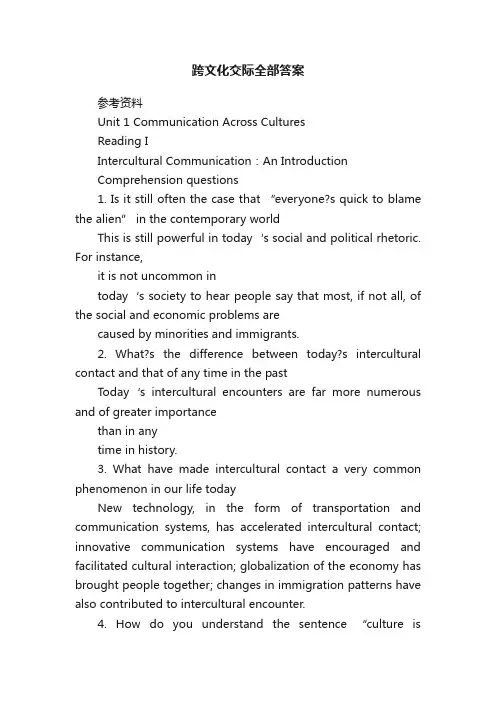
跨文化交际全部答案参考资料Unit 1 Communication Across CulturesReading IIntercultural Communication:An IntroductionComprehension questions1. Is it still often the case that “everyone?s quick to blame the alien” in the contemporary worldThis is still powerful in today‘s social and political rhetoric. For instance,it is not uncommon intoday‘s society to hear people say that most, if not all, of the social and economic problems arecaused by minorities and immigrants.2. What?s the difference between today?s intercultural contact and that of any time in the pastToday‘s intercultural encounters are far more numerous and of greater importancethan in anytime in history.3. What have made intercultural contact a very common phenomenon in our life todayNew technology, in the form of transportation and communication systems, has accelerated intercultural contact; innovative communication systems have encouraged and facilitated cultural interaction; globalization of the economy has brought people together; changes in immigration patterns have also contributed to intercultural encounter.4. How do you understand the sentence “culture iseverything and everywhere”Culture supplies us with the answers to questions about what the world looks like and how we live and communicate within that world. Culture teaches us how to behavein our life from the instant of birth. It is omnipresent.5. What are the major elements that directly influence our perception and communicationThe three major socio-cultural elements that directly influence perception and communication are cultural values, worldview (religion), and social organizations (family and state).6. What does one?s family teach him or her while he or she grows up in itThe family teaches the child what the world looks like and his or her place in that world.7. Why is it impossible to separate our use of language from our cultureBecause language is not only a form of preserving culture but also a means of sharing culture. Language is an organized, generally agreed-upon, learned symbol system that is used to represent the experiences within a cultural community.8. What are the nonverbal behaviors that people can attach meaning toPeople can attach meaning to nonverbal behaviors such as gestures, postures, facial expressions, eye contact and gaze, touch, etc.9. How can a free, culturally diverse society existA free, culturally diverse society can exist only if diversity is permitted to flourish without prejudice and discrimination, both of which harm all members of the society.Reading IIThe Challenge of GlobalizationComprehension questions1. Why does the author say that our understanding of the world has changedMany things, such as political changes and technological advances, have changed the world very rapidly. In the past most human beings were born, lived, and died within a limited geographical area, never encountering people of other cultural backgrounds. Such an existence, however, no longer prevails in the world. Thus, all people are faced with the challenge of understanding this changed and still fast changing world in which we live.2. What a “global village” is likeAs our world shrinks and its inhabitants become interdependent, people from remote cultures increasingly come into contact on a daily basis. In a ―global village‖, members of once isolated groups of people have to communicate with members of other cultural groups. Those people may live thousands of miles away or right next door to each other.3. What is considered as the major driving force of the post-1945 globalizationTechnology, particularly telecommunications and computers are considered to be the major driving force.4. What does the author mean by saying that “the …global?may be more local than the …local?”The increasing global mobility of people and the impact of new electronic media on human communications make the world seem smaller. We may communicate more with people of other countries than with our neighbors, and we may be more informed of the international events than of the local events. Inthis sense, ―the ?global‘ may be more local than the ?local‘‖.5. Why is it important for businesspeople to know diverse cultures in the worldEffective communication may be the most important competitive advantage that firmshave to meet diverse customer needs on a global basis. Succeeding in the global market today requires the ability to communicate sensitively with people from other cultures,a sensitivity that is based on an understanding of cross-cultural differences.6. What are the serious problems that countries throughout the world are confronted withCountries throughout the world are confronted with serious problems such as volatile international economy, shrinking resources, mounting environmental contamination, and epidemics that know no boundaries.7. What implications can we draw from the case of MichaelFayThis case shows that in a world of international interdependence, the ability to understand and communicate effectively with people from other cultures takes on extreme urgency. If we are unaware of the significant role culture plays in communication, we may place the blame for communication failure on people of other cultures.8. What attitudes are favored by the author towardsglobalizationGlobalization, for better or for worse, has changed the world greatly. Whether we like it or not, globalization is all but unstoppable. It is already here to stay. It is both a fact and an opportunity. The challenges are not insurmountable. Solutionsexist, and are waiting to be identified and implemented. From a globalistic point of view, there is hope and faith in humanity.Translation纵观历史,我们可以清楚地看到,人们由于彼此所处地域、意识形态、容貌服饰和行为举止上存在的差异,而长久无法互相理解、无法和睦相处。

文化差异与跨文化交际知到章节测试答案智慧树2023年最新郑州大学绪论单元测试1.古巴比伦发源于()。
参考答案:两河流域(幼发拉底河和底格里斯河)2.古罗马法律()成为现代西方国家的民法和经济法的核心。
参考答案:《自然法》;《万民法》;《十二铜表法》3.《几何原本》是由()所著。
参考答案:欧几里得4.中国最早的文字是(),发掘于河南安阳。
参考答案:甲骨文5.()不但是古罗马的一位伟大的政治家和军事家,而且在文学方面也颇有建树。
其名言是“I came, I saw, I conquered”,表现出凯撒勇敢、果断、强势的性格特征。
参考答案:凯撒大帝6.下列哪些建筑是古罗马的代表性建筑()。
参考答案:水渠;罗马斗兽场;万神庙7.()被称为世界四大名著之一——其它三部是但丁的《神曲》、歌德的《浮士德》以及莎士比亚的《哈姆雷特》。
参考答案:《荷马史诗》8.文明的三条标准包括()。
参考答案:有文字;有复杂的礼仪建筑,例如教堂、寺庙等等;有城市9.世界上最早的军事著作是()。
参考答案:《孙子兵法》10.世界上最早的哲学著作是()。
参考答案:《道德经》第一章测试1.张骞第一次出使西域虽然没有达到目的,但是却带回了大量西域的种植技术,为汉朝开辟通往中亚的交通要道提供了宝贵的资料。
参考答案:对2.利玛窦是一位天主教神父,也是一位西方的学者和汉学家。
他不仅在中国宣传西方的几何学、地理学知识,以及人文主义和天主教的观点,同时还向西方介绍中国文化。
参考答案:对3.公元3到14世纪,欧洲各国普遍使用羊皮纸书写文件,从14世纪起羊皮纸逐渐被中国的纸张所取代,羊皮纸从此退出历史舞台。
参考答案:错4.希腊著名数学家、物理学家阿基米德的《方法论》手稿重写本经美国科学家研究终于在X射线下回复了原有内容。
参考答案:对5.中西方文化交流的历史源远流长,历史上有一条连接东西方文明古国的通道被称之为“丝绸之路”。
“丝绸之路”的得名是由()提出的。

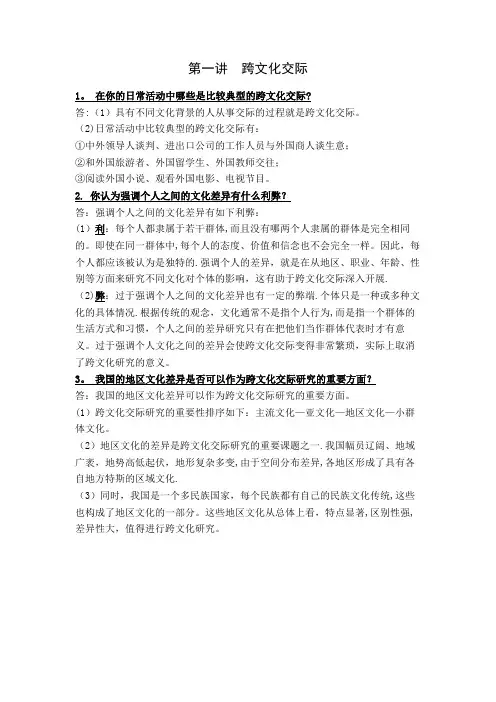
第一讲跨文化交际1。
在你的日常活动中哪些是比较典型的跨文化交际?答:(1)具有不同文化背景的人从事交际的过程就是跨文化交际。
(2)日常活动中比较典型的跨文化交际有:①中外领导人谈判、进出口公司的工作人员与外国商人谈生意;②和外国旅游者、外国留学生、外国教师交往;③阅读外国小说、观看外国电影、电视节目。
2. 你认为强调个人之间的文化差异有什么利弊?答:强调个人之间的文化差异有如下利弊:(1)利:每个人都隶属于若干群体,而且没有哪两个人隶属的群体是完全相同的。
即使在同一群体中,每个人的态度、价值和信念也不会完全一样。
因此,每个人都应该被认为是独特的.强调个人的差异,就是在从地区、职业、年龄、性别等方面来研究不同文化对个体的影响,这有助于跨文化交际深入开展. (2)弊:过于强调个人之间的文化差异也有一定的弊端.个体只是一种或多种文化的具体情况.根据传统的观念,文化通常不是指个人行为,而是指一个群体的生活方式和习惯,个人之间的差异研究只有在把他们当作群体代表时才有意义。
过于强调个人文化之间的差异会使跨文化交际变得非常繁琐,实际上取消了跨文化研究的意义。
3。
我国的地区文化差异是否可以作为跨文化交际研究的重要方面?答:我国的地区文化差异可以作为跨文化交际研究的重要方面。
(1)跨文化交际研究的重要性排序如下:主流文化—亚文化—地区文化—小群体文化。
(2)地区文化的差异是跨文化交际研究的重要课题之一.我国幅员辽阔、地域广袤,地势高低起伏,地形复杂多变,由于空间分布差异,各地区形成了具有各自地方特斯的区域文化.(3)同时,我国是一个多民族国家,每个民族都有自己的民族文化传统,这些也构成了地区文化的一部分。
这些地区文化从总体上看,特点显著,区别性强,差异性大,值得进行跨文化研究。
第二讲跨文化交际学1.跨文化交际学为什么产生在美国?答:跨文化交际学产生在美国有以下几个原因:(1)美国是一个移民国家。
除了印第安人以外,其他人都先后来自其他国家和地区.美国有来自欧洲、非洲、亚洲、拉丁美洲、大洋洲各国的移民.他们具有各自的文化传统和风俗习惯,他们在相互交际中难免产生问题,在年上世纪60年代,少数民族特别是黑人争取自己权利与地位的斗争风起云涌,民族意识日益增强,各少数民族都强调维护自己的文化,于是逐渐地在美国社会形成了多元文化的格局。
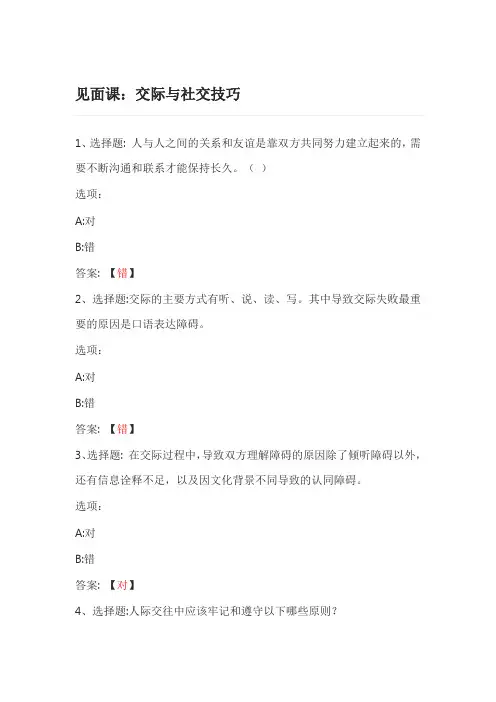
1、选择题: 人与人之间的关系和友谊是靠双方共同努力建立起来的,需要不断沟通和联系才能保持长久。
()选项:A:对B:错答案: 【错】2、选择题:交际的主要方式有听、说、读、写。
其中导致交际失败最重要的原因是口语表达障碍。
选项:A:对B:错答案: 【错】3、选择题: 在交际过程中,导致双方理解障碍的原因除了倾听障碍以外,还有信息诠释不足,以及因文化背景不同导致的认同障碍。
选项:A:对B:错答案: 【对】4、选择题:人际交往中应该牢记和遵守以下哪些原则?选项:A:尊重原则B:真诚原则C:守时原则D:宽容原则E:适度原则答案: 【尊重原则;真诚原则;守时原则;宽容原则;适度原则】5、选择题:在面试过程中,考官除了考察一个人的沟通能力、逻辑思维能力、判断推理能力以外,还会考察他的哪些能力?选项:A:应变能力B:反应能力C:心理素质D:社交礼仪答案: 【应变能力;反应能力;心理素质;社交礼仪】1、选择题:医疗援助、劳务输出以及出国探亲访友不属于国际交流。
选项:A:对B:错答案: 【错】2、选择题:联合国的六种官方语言包括英语、法语、德语、俄语、汉语和西班牙语。
选项:A:对B:错答案: 【错】3、选择题:国际礼仪是指在国际交往中约定俗成的行为规范,是国际交往中礼貌的具体表现形式。
选项:A:对B:错答案: 【对】4、选择题:中国文化属于高语境文化,美国文化属于低语境文化。
选项:A:对B:错答案: 【对】5、选择题:以下为他人介绍时,顺序正确的是:()选项:A: 把年轻的介绍给年长的B:把职务低者介绍给职务高者C:双方年龄、职务相当,则把男士介绍给女士D:把家人介绍给同事、朋友E:把熟悉的人介绍给不熟悉的人F: 把后来者介绍给先到者答案: 【把年轻的介绍给年长的;把职务低者介绍给职务高者;双方年龄、职务相当,则把男士介绍给女士;把家人介绍给同事、朋友;把熟悉的人介绍给不熟悉的人;把后来者介绍给先到者】1、选择题: 全球化发展趋势主要表现为()选项:A:世界多极化B:经济全球化C:文化多样化D: 社会信息化答案: 【世界多极化;经济全球化;文化多样化;社会信息化】2、选择题:亚洲文明大会的主题是“亚洲文明世界共融”。

o o o o oooooooooooo o o o o o o o o o o o o o o o o o o o o o o o o o o o o o o o o o o o o o oooooooooooo o o o o o o o o o o o o1.1丝绸之路1中西方文化交流的历史源远流长,历史上有一条连接东西方文明古国的通道被称之为“丝绸之路”。
“丝绸之路”的得名是由(D)提出的。
A、张骞B、汉和帝C汉武帝D李希霍芬2“丝绸之路”曾作为连接中西方的重要通道发挥着重要的作用。
不发挥的作用主要是指(B)。
A、贸易作用B、军事作用C外交作用3D文化交流作用3“丝绸之路”加强了东西方的贸易往来。
通过“丝绸之路”中国没将(B)运输到东南亚、南亚、东非以及欧洲各国。
A 号岂A、瓷器B、茶叶C香料D丝绸4古代丝绸之路不仅指陆上丝绸之路,还包括海上丝绸之路。
对5通过丝绸之路,中国人将四大发明传到欧洲;西方人将印度哲学、阿拉伯的历法和医术传入中国,促进了中西方文化的交流。
对1.2东西方文化传播1佛教传入中国后对中国文化的影响巨大。
中国历史上就曾修建过许多反映佛教文化的石窟,其中下面那个不是敦煌莫高窟与( A)并称为中国四大石窟。
A、固原须弥山石窟B、天水麦积山石窟C洛阳龙门石窟D大同云冈石窟希腊著名数学家、物理学家阿基米德的《方法论》手稿重写本经美国科学家研究终于在X射线下回复了原有内容。
AA、对B、错3张骞第二次出使西域大获成功,受到了汉武帝的称赞,被封为太中大夫。
AA、对B、错4马可?波罗著的《马可•波罗游记》记述了他在东方最富有的国家一—中国的所见所闻,激起了欧洲人对东方的热烈向往。
后来这本书在欧洲非常畅销。
错5公元3到13世纪,欧洲各国普遍使用羊皮纸书写文件,从14世纪起羊皮纸逐渐被中国的纸所取代,羊皮纸从此退出历史舞台。
错2.1文化符号1从下面哪些符号可以判断一个人的文化背景? CDE A、头发颜色B、眼睛颜色C语言D饮食E、宗教信仰下面哪些选项为中国符号?BDEA、佛教B、大熊猫C圣诞节D京剧E、长城3下面哪些选项为西方的文化符号?CDEA、茶B、风水D鸡尾酒E、快餐4豫剧是中国的国粹。
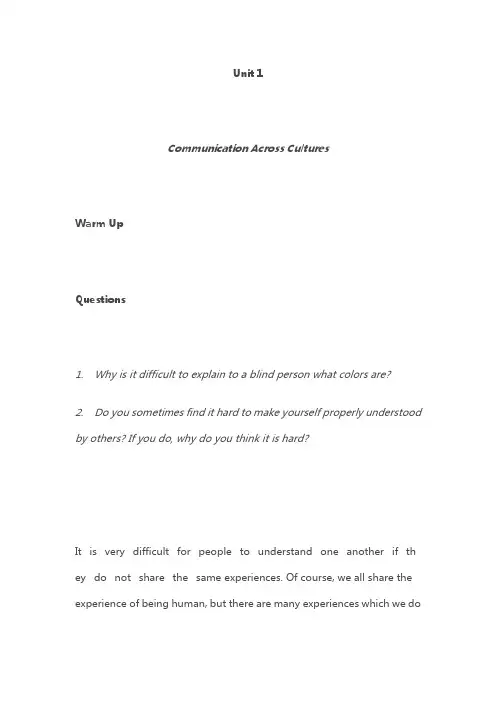
Unit 1Communication Across CulturesWarm UpQuestions1. Why is it difficult to explain to a blind person what colors are?2. Do you sometimes find it hard to make yourself properly understood by others? If you do, why do you think it is hard?It is very difficult for people to understand one another if th ey do not share the same experiences. Of course, we all share the experience of being human, but there are many experiences which we donot share and which are different for all of us. It is these different experiences thatmake up what is called ―culture‖ in the social sciences -the habits of everyday life, the cues towhich people respond, the automatic reactions they have to whatever they see and hear. These often differ, and the differences may introduce misunderstandings where we seek understanding.Reading IIntercultural Communication:An IntroductionComprehension questions1. Is it still often the case that“everyone‟s quick to blame the alien”in the contemporary world?This is still powerful in today‘s social and political rhetoric. For instance,it is not uncommon intoday‘s society to hear people say that most, if not all, of the social and economic problems arecaused by minorities and immigrants.2. What‟s the difference between today‟s intercultural contact and that of any time in the past?Today‘s intercultural encounters are far more numerous and of greaterimportance than in anytime in history.3. What have made intercultural contact a very common phenomenon in our life today?New technology, in the form of transportation and communication systems, has accelerated intercultural contact; innovative communication systems have encouraged and facilitated culturalinteraction; globalization of the economy has brought people together; changes in immigration patterns have also contributed to intercultural encounter.4. How do you understand the sentence“culture is everything and everywhere”?Culture supplies us with the answers to questions about what the world looks like and how we live and communicate within that world. Culture teaches us how to behave in our life from the instant of birth. It is omnipresent.5. What are the major elements that directly influence our perception and communication?The three major socio-cultural elements that directly influence perception and communication are cultural values, worldview (religion), and social organizations (family and state).6. What does one‟s family teach him or her while he or she grows up in it?The family teaches the child what the world looks like and his or her place in that world.7. Why is it impossible to separate our use of language from our culture? Because language is not only a form of preserving culture but also a means of sharing culture. Language is an organized, generallyagreed-upon, learned symbol system that is used to represent the experiences within a cultural community.8. What are the nonverbal behaviors that people can attach meaning to?People can attach meaning to nonverbal behaviors such as gestures, postures, facial expressions, eye contact and gaze, touch, etc.9. How can a free, culturally diverse society exist?A free, culturally diverse society can exist only if diversity is permitted to flourish without prejudice and discrimination, both of which harm all members of the society.Discovering Problems: Slim Is Beautiful?Questions for discussionWhich do you think is the mark of beauty, thin or fat? Why is it often said that beauty is in the eye of beholder?One sociologist once said that with the greater influence of American culture across the world, the standard of a beauty is becoming more and more Hollywood-like, characterized by a chiseled chin and a tall, slim figure. One can see such beautiful images in almost any American movie. We Chinese also share the notion that the standard idea of beauty includes being tall, thin, and light skinned. It seems that with the process of globalization, eastern and western beauties look more and more alike.But we have to remember that the definition of beauty differs from culture to culture. For example, Hispanic standards of female beauty are to have big hips, a moderate tan, and a short height. As is described in the article, in southeastern Nigeria, Coca-Cola-bottle voluptuousness is celebrated and ample backsides and bosoms are considered ideals of female beauty.What‘s more, the ideal standard of beauty varies from time to time. For instance, during timesof famine, the ideal standard of beauty for women is a much larger body size. Larger size and more body fat may reflect one‘s status; for it suggests that the person is well fed and healthy. Thinness then wouldreflect malnutrition. However, during times of plenty, plumpness is not a reflection ofstatus. People may easily associate fatness with hypertension, h eart disease or other potential diseases. Likewise, during eras in which lower-class labors had to toil predominantly outside for hours a day, tanned skin was an indication of lower status, and therefore the ideal standard of female beauty was very pale skin; women during those times actually used a lot of white powdered cosmetics to exaggerate the paleness of their skin. Now, however, tan is a reflection of having more leisure time spent on seashores instead of working in an office all the time, and therefore it may suggest higher status, so women strive for darker skin tones.It is true that beauty is in the eye of the beholder because people of different cultures and in different situations may have different ideas about what is beautiful and what is not.Group WorkFirst share with your group member whatever experiences you have had in communication events that can be considered as intercultural. Then work together to decide whether each of the following cases of communication is possibly intercultural or not and, if it is, to what extent it is intercultural. Try to place all the cases along a continuum of interculturalness, from the most intercultural to the least intercultural.All the cases may seem to be intercultural but they differ in the extent to which they are intercultural. However it may be very difficult for us to place all these cases along a continuum of interculturalness from the most intercultural to the least intercultural, for many other factors have to be taken into consideration if we have to decide which is more intercultural than another. For instance, whether communication between a male manager and a female secretary is intercultural or not and, if it is, how intercultural it may be, may depend on the cultural and social backgrounds of the two persons. If they are from drastically different cultures, communication between them is surely intercultural and may be very intercultural. If they are from the same culture, communication between them may be little intercultural.The following is tentatively suggested for measuringthe interculturalness of the cases of communication, and the cases are presented from the most intercultural to the least intercultural: Communication between a Chinese university student and an American professor; Communication between a Canadian girl and a South African boy;Communication between a first-generation Chinese American and third generation one; Communication between a businessperson from Hong Kong and an artist from Xian; Communication between a teenager from Beijing and a teenager from Tibet;Communication between a father who is a farmer all his life and his son who works as an engineer;Communication between a software technician and a fisherman; Communication between a male manager and a female secretary (supposing they are of the similar cultural and social backgrounds) .DebateThe class is to be divided into two groups and debate on the two different views mentioned in thefollowing on intercultural communication. State your point of vi ew clearly and support your argument with convincing and substantive evidence.Pro: People are people; more interactions would lead to greate r understanding of each other.(Commonality precedes)Con: People are shaped by different environments they find themselves in, therefore, the difference overrides. (Differences precedes)1. Human beings tend to draw close to one another by their common nature. We all share the common basic needs.2. Rapid expansion of worldwide transportation and communication networks have made it far easier than ever before for people throughout the world to contact with one another.3. The process of globalization may reduce the regional differences between people all over the world. We are all members of the ―global village‖.4. Economic interdependence in today‘s world requires people of different countries to interact onan unprecedented scale, and more interaction will result in more similarity among people.5. More and more people from various cultures have to work and live together and they will adapt to each other to such an extent that cultural differences between them may no longer matter.1. People throughout the world may be similar in many aspects, but differences in habits and customs keep them apart.2. Though the basic human needs are universally the same, people all over the world satisfy their basic common human needs in different ways.3. As our society is becoming more and more diversified, differences between people tend to grow larger in some aspects.4. It is differences between people that underlie the necessity of communication, and it does not follow that communication which may increase the possibility of understanding between people will always reduce differences.5. People nowadays are more likely to try to maintain their unique cultural identities when they find themselves living closely with people of other cultures.From the two seemingly opposite viewpoints, we can learn something that we should keep in mind when we are involved in interculturalcommunication. First, all human beings share some common heritages that link us to one another. To some extent, people throughout the world are pretty much alike in many aspects, and that has formed the very basis on which it is possible for people of various cultures to communicate. However, what we have to realize is that there are also vast differences between people from various cultural groups. To really understand a person whose cultural background is different from yours can be very difficult, for both you and that person maybe subconsciously influenced by each one‘s own cultural upbringing. In a sense, what we should doin intercultural communication is to treat people of other cultures both as the same with and as different from us.Reading IIThe Challenge of GlobalizationComprehension questions1. Why does the author say that our understanding of the world has changed?Many things, such as political changes and technological advances, have changed the world very rapidly. In the past most human beings were born, lived, and died within a limited geographical area, never encountering people of other cultural backgrounds. Such an existence, however, no longer prevails in the world. Thus, all people are faced with the challenge of understanding this changed and still fast changing world in which we live.2. What a“global village”is like?As our world shrinks and its inhabitants become interdependent, people from remote cultures increasingly come into contact on a daily basis. In a ―global village‖, members of once isolated groups of people have to communicate with members of other cultural groups. Those people may live thousands of miles away or right next door to each other.3. What is considered as the major driving force of the post-1945 globalization?Technology, particularly telecommunications and computers are considered to be the major driving force.4. What does the author mean by saying that“the…global‟may be more local than the…local‟”?The increasing global mobility of people and the impact of new electronic media on human communications make the world seem smaller. We may communicate more with people of other countries than with our neighbors, and we may be more informed of the international events than of the local events. In this sense, ―the ‗global‘may be more local than the ‗local‘‖.5. Why is it important for businesspeople to know diverse cultures in the world?Effective communication may be the most important competitive advantage that firms have tomeet diverse customer needs on a global basis. Succeeding in the global market today requires the ability to communicate sensitively with people from other cultures, a sensitivity that is based on an understanding of cross-cultural differences.6. What are the serious problems that countries throughout the world are confronted with?Countries throughout the world are confronted with serious problems such as volatile international economy, shrinking resources, mounting environmental contamination, and epidemics that know no boundaries.7. What implications can we draw from the case of Michael Fay?This case shows that in a world of international interdependence, the ability to understand and communicate effectively with people from other cultures takes on extreme urgency. If we are unaware of the significant role culture plays in communication, we may place the blame for communication failure on people of other cultures.8. What attitudes are favored by the author towards globalization? Globalization, for better or for worse, has changed the world greatly. Whether we like it or not, globalization is all but unstoppable. It is already here to stay. It is both a fact and an opportunity. The challenges are not insurmountable. Solutions exist, and are waiting to be identified and implemented. From a globalistic point of view, there is hope and faith in humanity.WritingRead the following and then try to write a short essay on what one has to learn to get prepared for working and living in a new cultural environment.There seems to be so much that one can do to get oneself well prepared for working and living in a new cultural environment. Apart from what is mentioned in the passage, the following may be what a person in Anna ‘s situation should also try to do:1. Learning the language that is used in the new cultural environment.2. Learning about the history and present social situation of the area or the country.3. Learning about the dominant religious belief and some important social customs.4. Learning about the cultural uses of nonverbal means inc luding time and space for communication.5. Learning to look at things and people in new perspectives that are different from what one is accustomed to.6. Developing a more tolerant attitude toward any unfamiliar phenomena.7. Becoming aware that problems and misunderstandings are inevitable in intercultural communication.8. Learning about how foreigners are usually perceived and treated by the local people.Identifying Difference: How We Address Each OtherQuestions for discussionHow do you address a friend from an English-speaking country? And how should we do it if he or she knows our culture very well or if we speak Chinese to each other?Usually we can address a friend from an English-speaking country by his/her first name withoutmentioning his/her surname or title out of respect for his/her culture. Because people from English-speaking countries attach great importance to casualness in addressing each other in order to form a relatively intimate and equal relationship. But if he or she knows our culture very well or if we speak Chinese to each other, we can address him/her in the Chinese way. Just as the old sayinggoes, ―When in Rome, do as the Romans do‖, it‘s better for our friend to learn more about andbecome better acquainted with the Chinese culture. In this way, when addressing him/her, we can add ―xiao‖(young) or ―lao‖(aged) before his/her family name according to his/her age so as to create an amicable atmosphere. We can also address him/her by using his/her title in a humorous way,or by inventing some nickname for him or her in either English or Chinese, depending on the degree of intimacy.SurveyConduct a survey among some Chinese students to find how much they know about the possible cultural differences between Chinese and English-speaking people in the speech behaviors listed below.SpeechbehaviorChina English-speaking countriesGreetin g When greeting each other, theChinese often begin with ―Have you eaten?‖, ―Where are yougoing?‖, ―What are youdoing?‖,―Long time no see.‖ and so on.People from English-speakingcountries usually say ―Hello.‖―Good morning/afternoon/evening‖―Nice to meet you./Glad to see you.‖or ―How doyou do?‖Apologi zing Chinese people seem toapologize less often thanPeople from English-speakingcountries often apologize inEnglish-speaking people. TheChinese apologize only whenthey think it is about somethingthat really matters.their daily life even for th e most trivial things.Making request s Chinese people tend to make requests in indirect ways, especially when the peop leinvolved are not on intimate terms with one another.People from English-speaking countries tend to mak e requests directly and openly.Express ing gratitu de Chinese people often expre ss their gratitude not just by what they say, but also by what they do and what they give to others who have done them a favor. People from English-speaking countries tend to show their gratitude more verbally t o others who have helpedthem.Express ing disappr Chinese people are reluctant to express their disproval openly for fear of making others lose face. If People from English-speaking countries are more likely to express their disapprovoval they have to express disapproval,they often prefer to do it in a veryindirect way.al freely and directly.Leave-t aking Chinese people tend to excusethemselves by claiming that theothers must be tired or busy, etc,using the expressions thatimputethe motive of tirednessor business to the other partywhen parting.People from English-speakingcountries would usually findreasons to part related tothemselves rather thanto others.Intercultural InsightExplorationTry to describe and explain the possible similar experiences in your use of English as a foreign language in communicating with native speakers.What a student tells us below can further illustrate the point that how we communicate appropriately in intercultural encounters may not be as simple as we tend to assume:I remember in the first class of oral English when I was a freshman at university, we students habitually addressed our amiable foreign teacher as ―teacher‖as we did to the other Chinese teachers. But he asked us to call him by his first name instead. Since he seemed morethan fifty years old we were embarrassed but gradually we learned that was the suitable way to address a teacher in the United States, for teachers in the United States generally prefer to be seen as equal and like a friend to their students. However, when I was already a junior, to our great surprise, one of our foreign teachers who taught us intensive reading told us that hepreferred to be called by us as ―Professor White‖ or ―Doctor White‖. The reason was simplythat he wanted to be properly respected in China.Translation纵观历史,我们可以清楚地看到,人们由于彼此所处地域、意识形态、容貌服饰和行为举止上存在的差异,而长久无法互相理解、无法和睦相处。
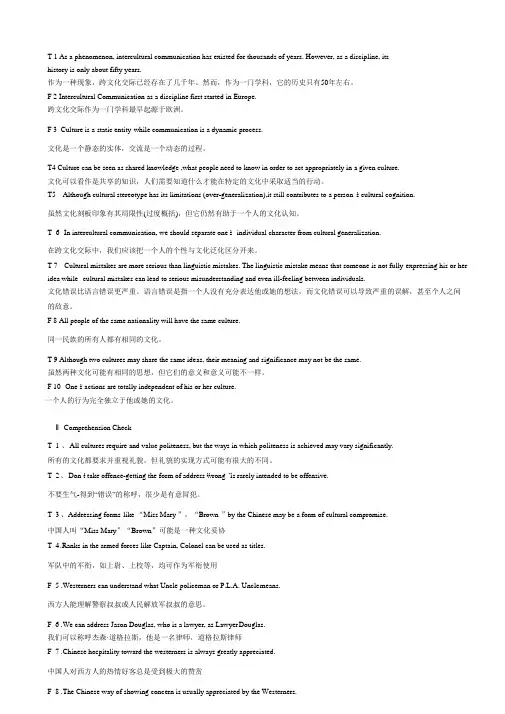
T 1 As a phenomenon, intercultural communication has existed for thousands of years. However, as a discipline, itshistory is only about fifty years.作为一种现象,跨文化交际已经存在了几千年。
然而,作为一门学科,它的历史只有50年左右。
F 2 Intercultural Communication as a discipline first started in Europe.跨文化交际作为一门学科最早起源于欧洲。
F 3 Culture is a static entity while communication is a dynamic process.文化是一个静态的实体,交流是一个动态的过程。
T4 Culture can be seen as shared knowledge ,what people need to know in order to act appropriately in a given culture.文化可以看作是共享的知识,人们需要知道什么才能在特定的文化中采取适当的行动。
T5 Although cultural stereotype has its limitations (over-generalization),it still contributes to a person ’s cultural cognition.虽然文化刻板印象有其局限性(过度概括),但它仍然有助于一个人的文化认知。
T 6 In intercultural communication, we should separate one ’s individual character from cultural generalization.在跨文化交际中,我们应该把一个人的个性与文化泛化区分开来。
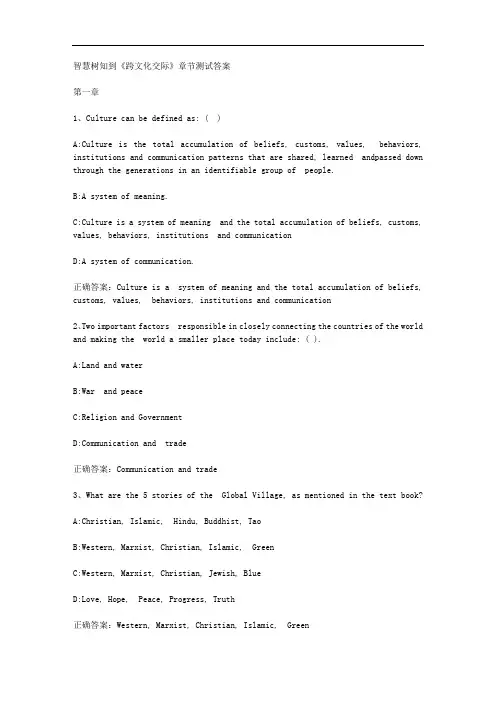
智慧树知到《跨文化交际》章节测试答案第一章1、Culture can be defined as: ( )A:Culture is the total accumulation of beliefs, customs, values, behaviors, institutions and communication patterns that are shared, learned andpassed down through the generations in an identifiable group of people.B:A system of meaning.C:Culture is a system of meaning and the total accumulation of beliefs, customs, values, behaviors, institutions and communicationD:A system of communication.正确答案:Culture is a system of meaning and the total accumulation of beliefs, customs, values, behaviors, institutions and communication2、Two important factors responsible in closely connecting the countries of the world and making the world a smaller place today include: ( ).A:Land and waterB:War and peaceC:Religion and GovernmentD:Communication and trade正确答案:Communication and trade3、What are the 5 stories of the Global Village, as mentioned in the text book?A:Christian, Islamic, Hindu, Buddhist, TaoB:Western, Marxist, Christian, Islamic, GreenC:Western, Marxist, Christian, Jewish, BlueD:Love, Hope, Peace, Progress, Truth正确答案:Western, Marxist, Christian, Islamic, Green4、“Learning about” a culture involves learning basic things related to that culture such as its history whereas “learning to do” a culture involves understanding why people in that culture behave and act the way they do.A:对B:错正确答案:对5、During the first level of cultural awareness, you start connecting with people from the different culture and begin understanding them.A:对B:错正确答案:错第二章1、The belief that your cultural group is superior to that of others is known as:( ).A:AgeismB:Cultural InferiorityC:Ethnocentrism or Cultural SuperiorityD: Levels of Culture正确答案:Ethnocentrism or Cultural Superiority2、What are subcultures?A:The many different kinds of prejudices many people have.B:The belief that your own culture is far superior to that of others.C:The many smaller cultures within a larger, national culture.D:They are overgeneralizations designed to hurt others.正确答案:The many smaller cultures within a larger, national culture.3、The different Levels of Culture include:( ).A:NationalB:RegionalC:GenerationalD: All the options are incorrect正确答案:All the options are incorrect4、Generalizations are hurtful/harmful. Stereotypes are helpful.A:对B:错正确答案:错5、To avoid stereotyping, one must avoid overgeneralizing.A:对B:错正确答案:对第三章1、Low context communicationis communication that occurs mostly through language.A:对B:错正确答案:A2、High context communication is communication that occurs mostly through language.A:对B:错正确答案:B3、What are examples of behavior codes?A:Books and magazinesB:Body language and social rolesC:Words people say and texts messagesD:Posters and past relationships正确答案:B4、What is one of the major sources of confusion, misunderstanding and frustration in cross-cultural communication?A:The difference in languages spoken by people from difference countries.B:The difference in age between the people communicating.C:The difference in jobs between the people communicating.D:The difference between high and low-context communication.正确答案:D5、For a Chinese student going to the United States for the first time, what might be a source of frustration?A:Only having written forms of communication and no one to help them in person.B:Not feeling confident with their speaking ability.C:The poor public transportation in the United States.D:Not being able to connect with new friends on WeChat.正确答案:A第四章1、Typically, Asians are more formal than westerners and older people are more formal than younger people.A:对B:错正确答案:A2、How do Westerners react to silence?A:They will feel uncomfortable and immediately leave the situation.B:They will likely feel uncomfortable and keep talking to stop the silence.C:They will listen and wait for another person to speak.D:They won’t notice the silence at all.正确答案:C3、Which of the following is a good question to ask in order to start a conversation with a foreigner?A:How long have you been in China?B:Can you use chopsticks?C:What is something that has surprised you the most about teaching in China?D:Can you speak Chinese?正确答案:C4、Westerners prefer to use indirect communication meaning that they say exactly what they think.A:对B:错正确答案:B5、When making first contact with a new person, which of the following matters?A:StatusB:The activityC:CultureD:The SettingE:All the options are incorrect正确答案:E6、In the West, friendships are based on the ability to help one another using personal connections. If someone does something for you, then it is your duty to pay them back with a helpful action later.A:对B:错正确答案:B7、Westerners often find it easy to understand the Chinese system of social credit and social debt because it is similar to how people act in the West.A:对B:错正确答案:B8、Typically, Westerners are much more informal in their friendships than Chinese people.A:对B:错正确答案:B9、Americans expect to gain and lose friendships naturally as their life changes. For example, they may have a group of close friends in high school that will changeonce they reach university.A:对B:错正确答案:A10、Which of the following is true about relationships in the West?A:Relationships often follow the rules of social debts and credits.B:Gift-giving is a common way to incur or repay social obligations in the West.C:Western friends typically have a more informal relationship than Chinese friends.D:Westerners dislike the feeling of dependence in friendships.正确答案:D第五章1、What is one possible reason that Americans don’t feel as attached to their surroundings as people from other cultures?A:America has fewer smells and therefore their surroundings do not have strong emotional attachments.B:Most places in American are considered to be ugly by Americans.C:American restaurants are too loud and Americans prefer peace and quiet.D:All the options are incorrect.正确答案:C2、Americans live in a low contact society.A:对B:错正确答案:A3、High Contact is where a culture prefers to use their vision in order to take in information, therefore they need to stand further away from an object in order to see the whole object and appreciate it.A:对B:错正确答案:B4、Why did the tribe from Central Africa describe the picture differently from how you or I would describe the photo?A:They don’t have the education to understand the picture.B:It was an intentional trick by the person who was showing them the picture.C:They didn’t have experience with photographs before and therefore perceived it differently.D:There was a language barrier and the westerner was not able to understand what the tribes people were saying.正确答案:C5、Perception is the way that something is understood or interpreted using your ability to see, hear, or use other senses.A:对B:错正确答案:A第六章1、What type of learning styleis common in China?A:A parent centered style of learning.B:A student centered style of learning.C:A teacher centered style of learning.D:Equality between the teacher and students.正确答案:C2、What is one of the purposes of pets in the United States?A:To have a friend, because it can be difficult to make friends.B:To satisfy the need for human touch.C:To satisfy the need of having someone listen to you.D:To satisfy the need of having someone be below you.正确答案:B3、How is the inside/outside pattern divided?A:Loud and softB:Rich and poorC:Private and publicD:Humans and animals正确答案:C4、In China, if you make eye contact and widen your eyes, it means you are angry. A:对B:错正确答案:A5、All humans around the world have learned to use their bodies the same.A:对B:错正确答案:B第七章1、With regards to social relationships, hierarchy means making your own decisions and choices that are best for you like what you want to eat for breakfast.A:对B:错正确答案:B2、If a culture has a past-oriented sense of time, what does that mean?A:Tradition is the best teacher.B:The past a future live together side by side.C:We should always be making plans for tomorrow.D:None of the options are incorrect.正确答案:A3、Westerners and Christians historically have believed which of the following?A:Humans are basically goodB:Humans are a mixture of good and evilC:Humans are basically evilD:All the options are incorrect正确答案:C4、What is an example from Chinese culture that shows a balance between living with nature and utilizing science?A:KungfuB:Economic developmentC:Chinese MedicineD:Chinese food正确答案:C5、Which of the following is not one of the 5 orientations from Kluckhohn’s model?A:Human NatureB:Sense of timeC:Social RelationshipsD:High context正确答案:D第八章1、At the Appreciation Stage of cultural adaptation, you are able to:( ).A:Forget about your home cultureB:Accept and appreciate both the similarities and differences of the new culture.C:Like some things from the new culture even more than the home culture.D:Appreciate both the similarities and differences of the new culture and Like some things from the new culture even more than the home culture.正确答案:D2、Experiencing culture shock upon returning home after spending time in a foreign country is known as: ( ).A:Culture ShockB:Culture Shock Part 2C:Culture Shock ReturnsD:Reverse Culture Shock正确答案:D3、A good strategy to adopt if you are feeling lonely in a foreign culture would be: ( ).A:Return to your home culture.B:Try and make friends (both international friends and local friends).C:Talk to friends and family members back home regularly.D:Eat food from your local culture to comfort you.正确答案:B4、One’s perception is shaped by one’s culture.A:对B:错正确答案:A5、Confusion and frustration are commonly experienced during culture shock.A:对B:错正确答案:B。
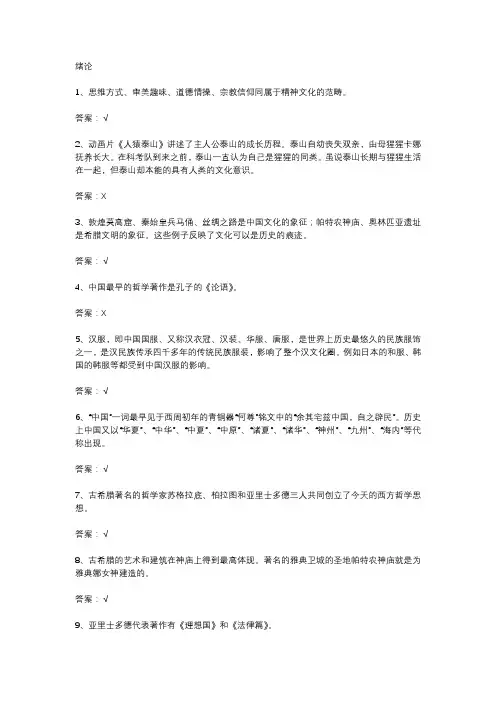
第一章:1.跨文化沟通具有下列哪些特征?A.是一个比较普遍的现象B.仅仅发生在与外国人面对面的交流中C.已经有数千年的历史了D.是一种常见的生活事件2.文化具有下列哪些特征?A.文化是后天习得的B.文化是可以共享的C.文化以符号为基础D.文化是一种动态过程3.你怎样让一个法国人知道你很不耐烦了?A.拍拍你的嘴唇并且打一个长长的哈欠B.无声的模仿吹长笛C.用中指和食指按你的鼻子B4.在Belay的综合性三维度模型中,跨文化敏感性是情感角度的跨文化沟通能力。
A.对B错A5.文化意识是指对影响自我、思维和行为的文化有所了解,让人们理解差异性和共同性。
A.对B.错A第二章:1.美国的主导文化模式包括下列哪些特征?A.个人主义B.集体主义C.物质主义D.竞争ACD2.根据霍夫斯泰德的价值观维度,以下倾向于个人主义价值观的国家有?A.美国B.澳大利亚C.中国D.日本AB3.请判断以下观点的对错:每一个个体都拥有多重文化身份,例如种族身份、民族身份、性别身份、地域身份、网络或幻想身份等,这些身份彼此合作,任一身份都是环境的产物。
A.对B.错A4.男性气质文化是指大男子主义盛行的文化。
A.对B.错B5.开放思维包括个体表达自己的想法,并倾听或接受他人的观点。
A.对B.错A第三章:1.在高情境文化中,情境和非言语对理解说话者想要表达的意思非常重要。
这个表述是正确的吗?A.对B.错A2.在有些文化中,人们更愿意表达自己的情绪,有更丰富的肢体语言,这种文化是:A.中性文化B.感性文化C.高情境文化D.低情境文化B3.相比于高情境文化中的人,在谈话中,当双方很长一段时间都不说话时,来自低情境文化的人会觉得不舒服。
A.对B.错A4.下列关于成就型文化与附属型文化不正确的描述是:A.在附属型文化中,将一个人身份地位和所属的组织联系起来是很重要的。
B.在附属型文化中,初次见面的人可能相互问“你学的是什么”、“你从哪里毕业的”。
让知识带有温度。
胡文仲《跨文化交际学概论》课后习题详解(第1章跨文化交际)【圣才出品】第1章跨文化交际1.在你的日常活动中哪些是比较典型的跨文化交际?答:具有不同文化背景的人从事交际的过程就是跨文化交际,日常活动中比较典型的跨文化交际有:(1)进出口公司的工作人员与外国商人谈生意;(2)我们和外国旅游者、外国留同学、外国老师交往;(3)阅读外国小说,观察外国电影、电视节目的过程等等。
2.你认为强调个人之间的文化差异有什么利弊?答:强调个人之间的文化差异的利弊有:(1)利:每个人都隶属于若干群体,而且,没有两个人隶属的群体是彻低相同的。
即使在同一群体中每个人的态度、价值和信心也不会彻低一样。
因此,每个人都应当被认为是独特的,强调个人的差异,就是在从地区、职业、年龄、性别等方面来讨论不同文化对个体的影响,这有助于跨文化交际深化开展。
(2)弊:过于强调个人间的文化差异也有一定弊端,个体只是一种或多种文化的详细状况,按照传统的观念,文化通常不是指个人行为,而是指一个群体的生活方式和习惯,个人间的差异讨论惟独在我们把他们当作群体代表时才故意义,没听过“个人文化”的说法。
过分强调个人文化间的差异会使跨文化交际变得十分繁琐,实际上取消第1页/共2页千里之行,始于足下了跨文化讨论的意义。
3.我国的地区文化差异是否可以作为跨文化交际讨论的重要方面?答:我国的地区文化差异可以作为跨文化交际讨论的重要方面。
(1)跨文化交际讨论的重要性排序如下:主流文化——亚文化——地区文化——小群体文化。
(2)地区文化的差异是跨文化交际讨论的重要课题之一。
我国幅员辽阔、地域广袤,地势凹凸起伏,地形复杂多变,因为空间分布差异,各地区形成了具有各自地方特色的区域文化。
(3)同时,我国是一个多民族国家,每个民族都有自己的民族文化传统,这些也构成了地区文化的一部分。
这些地区文化,从总体上看,特点显著,区分性强,差异性大,值得举行跨文化讨论。
《文化差异与跨文化交际》2019章节测试题与答案绪论1、思维方式、审美趣味、道德情操、宗教信仰同属于精神文化的范畴。
A.对B.错答案: 对2、动画片《人猿泰山》讲述了主人公泰山的成长历程。
泰山自幼丧失双亲,由母猩猩卡娜抚养长大。
在科考队到来之前,泰山一直认为自己是猩猩的同类。
虽说泰山长期与猩猩生活在一起,但泰山却本能的具有人类的文化意识。
A.对B.错答案: 错3、敦煌莫高窟、秦始皇兵马俑、丝绸之路是中国文化的象征;帕特农神庙、奥林匹亚遗址是希腊文明的象征。
这些例子反映了文化可以是历史的痕迹。
A.对B.错答案: 对4、中国最早的哲学著作是孔子的《论语》。
A.对B.错答案: 错5、汉服,即中国国服、又称汉衣冠、汉装、华服、唐服,是世界上历史最悠久的民族服饰之一,是汉民族传承四千多年的传统民族服装,影响了整个汉文化圈。
例如日本的和服、韩国的韩服等都受到中国汉服的影响。
A.对B.错答案: 对6、“中国”一词最早见于西周初年的青铜器“何尊”铭文中的“余其宅兹中国,自之辟民”。
历史上中国又以“华夏”、“中华”、“中夏”、“中原”、“诸夏”、“诸华”、“神州”、“九州”、“海内”等代称出现。
A.对B.错答案: 对7、古希腊著名的哲学家苏格拉底、柏拉图和亚里士多德三人共同创立了今天的西方哲学思想。
A.对B.错答案: 对8、古希腊的艺术和建筑在神庙上得到最高体现。
著名的雅典卫城的圣地帕特农神庙就是为雅典娜女神建造的。
A.对B.错答案: 对9、亚里士多德代表著作有《理想国》和《法律篇》。
B.错答案: 错10、古罗马的《十二铜表法》、《万民法》、《自然法》成为现代西方国家的宪法的核心。
A.对B.错答案: 错11、哲学家卢克莱修认为善行产生快乐,智者就是依照理性指导而生活的人,因而不为烦忧痛苦所困扰。
A.对B.错答案: 错12、古罗马的代表性建筑有万神殿、罗马竞技场、圆形大剧场、君士坦丁凯旋门,罗马水渠等。
A.对答案: 对13、在印度,一个名叫莫戈里的男孩从小就与狼一起生活,只会用狼嚎的形式进行交流。
智慧树知到《文化差异与跨文化交际》见面课答案智慧树知到《文化差异与跨文化交际》见面课答案见面课:交际与社交技巧1、人与人之间的关系和友情是靠双方共同努力建立起来的,需要不断沟通和联系才能保持长期。
〔〕A.对B.错正确答案:错2、交际的主要方式有听、说、读、写。
其中导致交际失败最重要的缘由是口语表达障碍。
A.对B.错正确答案:错3、在交际过程中,导致双方理解障碍的缘由除了倾听障碍以外,还有信息诠释缺乏,以及因文化背景不同导致的认同障碍。
A.对B.错正确答案:对4、人际交往中应当牢记和遵守以下哪些原那么?A.敬重原那么B.真诚原那么C.守时原那么D.宽容原那么E.适度原那么正确答案:敬重原那么;真诚原那么;守时原那么;宽容原那么;适度原那么5、在面试过程中,考官除了考察一个人的沟通能力、规律思维能力、推断推理能力以外,还会考察他的哪些能力?A.应变能力B.反应能力C.心理素养D.社交礼仪正确答案:应变能力;反应能力;心理素养;社交礼仪见面课:国际沟通与社交礼仪1、医疗救援、劳务输出以及出国探亲访友不属于国际沟通。
A.对B.错正确答案:错2、联合国的六种官方语言包括英语、法语、德语、俄语、汉语和西班牙语。
A.对B.错正确答案:错3、国际礼仪是指在国际交往中商定俗成的行为规范,是国际交往中礼貌的具体表现形式。
A.对B.错正确答案:对4、中国文化属于高语境文化,美国文化属于低语境文化。
A.对B.错正确答案:对5、以下为他人介绍时,顺序正确的选项是:〔〕A. 把年轻的介绍给年长的B.把职务低者介绍给职务高者C.双方年龄、职务相当,那么把男士介绍给女士D.把家人介绍给同事、伴侣E.把熟识的人介绍给不熟识的人F. 把后来者介绍给先到者正确答案:把年轻的介绍给年长的;把职务低者介绍给职务高者;双方年龄、职务相当,那么把男士介绍给女士;把家人介绍给同事、伴侣;把熟识的人介绍给不熟识的人;把后来者介绍给先到者见面课:文化全球化与本土文化1、全球化进展趋势主要表现为〔〕A.世界多极化B.经济全球化C.文化多样化D. 社会信息化正确答案:世界多极化;经济全球化;文化多样化;社会信息化2、亚洲文明大会的主题是"亚洲文明世界共融'。
第一章 1【单选题】(10分)中西方文化交流的历史源远流长,历史上有一条连接东西方文明古国的通道被称之为“丝绸之路”。
“丝绸之路”的得名是由()提出的。
A. 张骞B. 汉和帝C. 汉武帝D. 李希霍芬正确查看答案解析10分2【多选题】(10分)广义上的“丝绸之路”除了包括陆上丝绸之路外,还包括海上丝绸之路。
海上丝绸之路由()组成。
A. 东洋航线B. 西洋航线C. 南洋航线D. 北洋航线正确查看答案解析10分3【多选题】(10分)“丝绸之路”曾作为连接中西方的重要通道发挥着重要的作用。
其发挥的作用主要是指()。
A. 贸易作用B. 军事作用C. 外交作用D. 文化交流作用正确查看答案解析10分4【单选题】(10分)通过“陆上丝绸之路”,于()年粟特人将制造葡萄酒的技术传入中国。
A. 贞观十四年B. 康熙九年C. 崇祯十六年D. 元和七年正确查看答案解析10分5【单选题】(10分)汉武帝时期,()为开拓“丝绸之路”立下了汗马功劳,被誉为“中国走向世界第一人”。
A. 卫青B. 霍去病C. 张骞D. 司马迁正确查看答案解析10分6【多选题】(10分)鸠摩罗什把佛教从西方引入中国,将大量经书翻译成汉语,为佛教在中国的传播做出了巨大的贡献。
他与()和玄奘并称为中国佛教四大译经家。
A. 不空B. 鉴真C. 法显D. 真谛正确查看答案解析10分7【单选题】(10分)()17岁时跟随父亲和叔叔历时四年来到中国,与元世祖忽必烈建立了友谊。
后由鲁斯蒂谦将其在中国见闻轶事整理并编著成游记,在欧洲广为流传,激起了欧洲人对东方的向往。
A. 查理·马特B. 马可•波罗C. 利玛窦D. 阿基米德正确查看答案解析10分8【多选题】(10分)佛教传入中国后对中国文化的影响巨大。
中国历史上就曾修建过许多反映佛教文化的石窟,其中敦煌莫高窟与()并称为中国四大石窟。
A. 固原须弥山石窟B. 天水麦积山石窟C. 洛阳龙门石窟D. 大同云冈石窟正确查看答案解析10分9【多选题】(10分)利玛窦不仅将中国文化介绍到了西方,而且帮助中国人打开了视野,使中国人了解到了西方。
正是由于他的到来,使中国人第一次接触到了()。
A. 西洋音乐B. 西方油画C. 机械钟表D. 西方哲学正确答案是:A,B,C查看答案解析10【多选题】(10分)“丝绸之路”加强了东西方的贸易往来。
通过“丝绸之路”中国将()运输到东南亚、南亚、东非以及欧洲各国。
A. 瓷器B. 茶叶C. 香料D. 丝绸正确答案是:A,B,D第二章 1【单选题】(5分)山姆大叔是哪个国家的绰号A. 中国B. 英国C. 德国D. 美国正确查看答案解析5分2【多选题】(5分)下面哪些选项为西方的文化符号?A. 茶B. 风水C. 牛仔D. 鸡尾酒E. 快餐正确查看答案解析5分3【多选题】(5分)下面哪些选项为中国符号?A. 佛教B. 熊猫C. 圣诞节D. 京剧E. 长城正确查看答案解析4【多选题】(5分)2008年北京奥运会开幕式中,张艺谋导演展现给世人的中国符号有:A. 北京天坛B. 丝绸之路C. 中国国旗D. 大熊猫E. 四大发明正确答案是:B,E查看答案解析5【多选题】(5分)从下面哪些符号可以判断一个人的文化背景?A. 头发颜色B. 眼睛颜色C. 语言D. 饮食E. 宗教正确查看答案解析5分6【多选题】(5分)下面哪些属于中国八大建筑流派?A. 江南民居B. 川西民居C. 蒙古包D. 北京四合院E. 书院建筑查看答案解析5分7【多选题】(5分)西方四大建筑风格分别是:A. 巴洛克式建筑B. 美国式建筑C. 罗马式建筑D. 哥特式建筑E. 洛可可建筑正确查看答案解析5分8【多选题】(5分)中国古典建筑风格可以用以下哪12个字概括?A. 金碧辉煌B. 雕梁画柱C. 飞檐斗拱D. 亭台楼阁正确查看答案解析5分9【多选题】(5分)下面哪些建筑属于罗马式建筑?A. 德国科隆大教堂B. 伦敦圣保罗大教堂C. 梵蒂冈圣保罗大教堂D. 意大利米兰大教堂E. 巴黎圣母院大教堂正确答案是:B,C查看答案解析10【单选题】(5分)华丽精巧、细腻柔媚、纤弱温柔、纷繁琐细是哪种建筑风格的特征?A. 中国园林建筑B. 巴洛克式建筑C. 洛可可式建筑D. 哥特式建筑正确查看答案解析5分11【多选题】(5分)下面哪些属于中国八大菜系?A. 粤菜B. 豫菜C. 湘菜D. 川菜E. 鲁菜正确查看答案解析5分12【多选题】(5分)下面哪些是中餐餐具?A. 勺子B. 叉子C. 筷子D. 盆子E. 碗正确答案是:A,C,D,E查看答案解析【多选题】(5分)中国茶的种类主要有A. 红茶B. 白茶C. 奶茶D. 黑茶E. 绿茶正确查看答案解析5分14【多选题】(5分)下面不属于西方酒吧文化中酒的品牌和分类的是:A. 二锅头B. 鸡尾酒C. XOD. 啤酒E. 黄酒正确查看答案解析5分15【多选题】(5分)属于中国五大戏曲种类的有:A. 豫剧B. 淮剧C. 黄梅戏D. 京剧E. 评剧正确查看答案解析16【多选题】(5分)下面哪些属于中国民族乐器?A. 大提琴B. 吉他C. 扬琴D. 古琴E. 木琴正确答案是:C,D查看答案解析17【多选题】(5分)下面哪些属于十大世界著名歌剧?A. 睡美人B. 茶花女C. 卡门D. 仙女E. 图兰朵正确查看答案解析5分18【多选题】(5分)达芬奇的代表作有:A. 星空B. 最后的晚餐C. 蒙娜丽莎D. 大卫正确查看答案解析5分19【单选题】(5分)《羊毛剪子咔嚓响》是哪国的民歌?A. 澳大利亚B. 西班牙C. 爱尔兰D. 苏格兰正确查看答案解析5分20【单选题】(5分)请将下面西餐点餐的正确顺序排序:A.饮品B. 开胃品C. 主菜D. 汤E. 甜点A. BDCEAB. BEDCAC. ACEDBD. DBACE正确案解析第三章1【多选题】(5分)口头交际方式具有哪些特征?A. 生动形象B. 互动性强C. 反馈及时D. 易于达成协议正确答案是:A,B,C,D查看答案解析2【多选题】(5分)书信是书面交际方式的一种。
历史上著名的《傅雷家书》就是傅雷夫妇写给谁的书信集?A. 傅聪B. 傅钦C. 傅敏D. 傅雷正确查看答案解析5分3【多选题】(5分)在当代,虚拟交际方式普遍应用于日常生活交际中。
在下列选项中,哪些不是中国人常用的社交软件?A. QQB. WechatC. SKYPED. TWITTER正确查看答案解析5分4【多选题】(5分)社交场所的选择应考虑交际者的哪些因素?A. 文化背景B. 身高C. 年龄D. 职业正确答案是:A,C,D查看答案解析5【多选题】(5分)与传统交际方式相比,现代交际方式具有哪些特点?A. 受众面广B. 更正式C. 更客观D. 不受时空限制正确答案是:A,D查看答案解析6【多选题】(5分)人际交往中要遵循一定的基本原则,其中包括尊重原则和()。
A. 真诚原则B. 守时原则C. 宽容原则D. 适度原则正确查看答案解析5分7【单选题】(5分)下列关系中,哪种不属于姻亲关系?A. 妯娌关系B. 翁婿关系C. 叔嫂关系D. 叔侄关系正确查看答案解析5分8【多选题】(5分)血缘关系具有下列哪些特点?A. 自然形成B. 无需刻意建立C. 恒久不变D. 社会建构正确查看答案解析5分9【多选题】(5分)下列谚语中,哪些反映了人际交往中的宽容原则?A. 宰相肚里能撑船。
B. 人非圣贤孰能无过?C. 己所不欲勿施于人。
D. 退一步海阔天空。
正确查看答案解析5分10【多选题】(5分)人际交往中的适度原则除了态度适度以外还应该注意什么适度?A. 言语适度B. 语气适度C. 举止适度D. 装扮适度正确查看答案解析5分11【多选题】(5分)俗话说:“人靠衣装,马靠鞍。
”此句话体现了衣着得体在人际交往中的重要性。
下列哪种情形需要穿着正装?A. 面试B. 外出旅行C. 出席婚礼D. 谈判正确查看答案解析5分12【多选题】(5分)下列哪些俗语表现了在人际交际过程中慎言的重要性和必要性?A. 祸从口出B. 言多必失C. 沉默是金D. 人怕出名猪怕壮正确答案是:A,B,C,D查看答案解析13【单选题】(5分)在西方,当面拒绝别人借钱或借车的请求,会被认为是______。
A. 不礼貌的B. 自私的C. 合理的D. 冷漠的正确查看答案解析5分14【单选题】(5分)在小品《有事您说话》中,讲述了由郭冬临扮演的男主人公连夜排队为人买票的事情。
这部小品主要是在表达社会交往中应有_____。
A. 助人为乐的精神B. 合理的拒绝C. 与人为善的精神D. 包容的精神正确答案是:A查看答案解析15【多选题】(5分)在交际过程中难免会遇到一些令人不愉快或者是尴尬的局面,_____是化解矛盾的法宝。
A. 机智B. 幽默C. 包容D. 妥协正确查看答案解析5分16【多选题】(5分)在西方,什么时间打电话会被对方认为是不合时宜的,不礼貌的?A. 清晨B. 晚8点以后C. 下午5点以后D. 晚10点半以后正确查看答案解析5分17【多选题】(5分)下列哪些做法在中国是可以接受的,而在西方则被认为是不合适的?A. 于约定时间前去朋友家做客B. 对长辈直呼其名C. 临时起意邀请朋友过来用餐D. 朋友婚礼赠送礼金正确查看答案解析5分18【多选题】(5分)在宴请客人吃饭时,中国人会怎么做?A. 当面拒绝接受不喜欢的菜B. 主人为客人夹菜C. 相互劝酒D. 客套表示谦虚正确查看答案解析5分19【多选题】(5分)英语中有句习语:“英国人的家是一座城堡。
”意思是英国人______。
A. 注重个人隐私B. 把家视为私人的空间C. 都有庄园梦D. 崇尚骑士精神正确查看答案解析5分20【多选题】(5分)在英美国家,应朋友邀请去对方家里做客,一般会()。
A. 于约定时间后五到十分钟到达B. 准时到达C. 于约定时间后一小时到达D. 提前到达正确第四章1【多选题】(7分)语境这一概念最早由波兰人类学家B.Malinowski在1923年提出来的。
他将语境分为哪两类?A. 情景语境B. 人文语境C. 文化语境D. 隐含语境正确查看答案解析7分2【多选题】(7分)在美国,询问对方哪些方面的问题会导致交际失败?A. 天气状况B. 是否已婚C. 体育爱好D. 收入财产正确查看答案解析7分3【单选题】(4分)百合花在中国文化中的含义是 ___。
A. 百年好合B. 葬礼C. 祝寿D. 道歉正确查看答案解析4分4【多选题】(7分)影响跨文化交际能力的三大要素为:______。
A. 应试能力B. 外语能力C. 语用能力D. 文化背景知识正确查看答案解析7分5【多选题】(7分)语言交际分为____和_______两种。
A. 口语交际B. 书面语交际C. 身体语言交际D. 手势语言交际正确查看答案解析7分6【多选题】(7分)高语境的语言特点是__________。